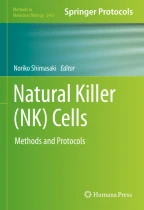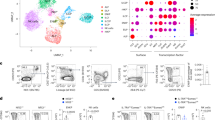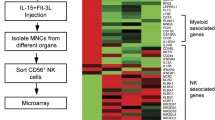In Vitro Development of Mouse and Human NK Cells from Hematopoietic Progenitor Cells

Natural killer (NK) cells are lymphocytes that play an important role at clearing virally infected or cancer cells. Their potential and role in cancer immunotherapy have generated great interest, given the promising results of NK cell adoptive transfer clinical trials. The remaining challenge to bring emerging NK cell immunotherapies to the clinic is to enhance the production of large numbers of functionally competent NK cells ex vivo. Here, we describe two in vitro NK cell development assays using hematopoietic progenitor cells (HPCs), one for human NK cells and one for mouse NK cells. These protocols describe two robust methods that can be utilized for investigation of NK cell development and function.
This is a preview of subscription content, log in via an institution to check access.
Access this chapter
Subscribe and save
Springer+ Basic
€32.70 /Month
- Get 10 units per month
- Download Article/Chapter or eBook
- 1 Unit = 1 Article or 1 Chapter
- Cancel anytime
Buy Now
Price includes VAT (France)
eBook EUR 128.39 Price includes VAT (France)
Softcover Book EUR 163.51 Price includes VAT (France)
Hardcover Book EUR 232.09 Price includes VAT (France)
Tax calculation will be finalised at checkout
Purchases are for personal use only
Similar content being viewed by others

Distinct developmental pathways generate functionally distinct populations of natural killer cells
Article 13 June 2024

Delineation of Natural Killer Cell Differentiation from Myeloid Progenitors in Human
Article Open access 12 October 2015

Hematopoietic and Nature Killer Cell Development from Human Pluripotent Stem Cells
Chapter © 2013
References
- Abel AM, Yang C, Thakar MS, Malarkannan S (2018) Natural killer cells: development, maturation, and clinical utilization. Front Immunol 9:1869. https://doi.org/10.3389/fimmu.2018.01869ArticleCASPubMedPubMed CentralGoogle Scholar
- Freud AG, Caligiuri MA (2006) Human natural killer cell development. Immunol Rev 214:56–72. https://doi.org/10.1111/j.1600-065X.2006.00451.xArticleCASPubMedGoogle Scholar
- Montaldo E, Del Zotto G, Della Chiesa M, Mingari MC, Moretta A, De Maria A, Moretta L (2013) Human NK cell receptors/markers: a tool to analyze NK cell development, subsets and function. Cytometry A 83:702–713. https://doi.org/10.1002/cyto.a.22302ArticlePubMedGoogle Scholar
- Wu Y, Tian Z, Wei H (2017) Developmental and functional control of natural killer cells by cytokines. Front Immunol 8:930. https://doi.org/10.3389/fimmu.2017.00930ArticleCASPubMedPubMed CentralGoogle Scholar
- Zhu H, Kaufman DS (2019) An improved method to produce clinical-scale natural killer cells from human pluripotent stem cells. Methods Mol Biol 2048:107–119. https://doi.org/10.1007/978-1-4939-9728-2_12ArticleCASPubMedGoogle Scholar
- Domogala A, Blundell M, Thrasher A, Lowdell MW, Madrigal JA, Saudemont A (2017) Natural killer cells differentiated in vitro from cord blood CD34+ cells are more advantageous for use as an immunotherapy than peripheral blood and cord blood natural killer cells. Cytotherapy 19:710–720. https://doi.org/10.1016/j.jcyt.2017.03.068ArticleCASPubMedGoogle Scholar
- Hordyjewska A, Popiołek Ł, Horecka A (2015) Characteristics of hematopoietic stem cells of umbilical cord blood. Cytotechnology 67:387–396. https://doi.org/10.1007/s10616-014-9796-yArticleCASPubMedGoogle Scholar
- Herrera L, Salcedo JM, Santos S, Vesga MÁ, Borrego F, Eguizabal C (2017) OP9 feeder cells are superior to M2-10B4 cells for the generation of mature and functional natural killer cells from umbilical cord hematopoietic progenitors. Front Immunol 8:755. https://doi.org/10.3389/fimmu.2017.00755ArticleCASPubMedPubMed CentralGoogle Scholar
- Haddad R, Guardiola P, Izac B, Thibault C, Radich J, Delezoide A-L, Baillou C, Lemoine FM, Gluckman JC, Pflumio F, Canque B (2004) Molecular characterization of early human T/NK and B-lymphoid progenitor cells in umbilical cord blood. Blood 104:3918–3926. https://doi.org/10.1182/blood-2004-05-1845ArticleCASPubMedGoogle Scholar
- Grzywacz B, Kataria N, Sikora M, Oostendorp RA, Dzierzak EA, Blazar BR, Miller JS, Verneris MR (2006) Coordinated acquisition of inhibitory and activating receptors and functional properties by developing human natural killer cells. Blood 108:3824–3833. https://doi.org/10.1182/blood-2006-04-020198ArticleCASPubMedPubMed CentralGoogle Scholar
- McCullar V, Oostendorp R, Panoskaltsis-Mortari A, Yung G, Lutz CT, Wagner JE, Miller JS (2008) Mouse fetal and embryonic liver cells differentiate human umbilical cord blood (UCB) progenitors into CD56 negative NK cell precursors in the absence of IL-15. Exp Hematol 36:598–608. https://doi.org/10.1016/j.exphem.2008.01.001ArticleCASPubMedPubMed CentralGoogle Scholar
- Hoogstad-van Evert JS, Cany J, van den Brand D, Oudenampsen M, Brock R, Torensma R, Bekkers RL, Jansen JH, Massuger LF, Dolstra H (2017) Umbilical cord blood CD34+ progenitor-derived NK cells efficiently kill ovarian cancer spheroids and intraperitoneal tumors in NOD/SCID/IL2Rgnull mice. Onco Targets Ther 6:e1320630. https://doi.org/10.1080/2162402X.2017.1320630ArticleGoogle Scholar
- Perez SA, Mahaira LG, Demirtzoglou FJ, Sotiropoulou PA, Ioannidis P, Iliopoulou EG, Gritzapis AD, Sotiriadou NN, Baxevanis CN, Papamichail M (2005) A potential role for hydrocortisone in the positive regulation of IL-15-activated NK-cell proliferation and survival. Blood 106:158–166. https://doi.org/10.1182/blood-2004-08-3232ArticleCASPubMedGoogle Scholar
- Spanholtz J, Tordoir M, Eissens D, Preijers F, van der Meer A, Joosten I, Schaap N, de Witte TM, Dolstra H (2010) High log-scale expansion of functional human natural killer cells from umbilical cord blood CD34-positive cells for adoptive cancer immunotherapy. PLoS One 5:e9221. https://doi.org/10.1371/journal.pone.0009221ArticleCASPubMedPubMed CentralGoogle Scholar
- Yu J, Freud AG, Caligiuri MA (2013) Location and cellular stages of natural killer cell development. Trends Immunol 34:573–582. https://doi.org/10.1016/j.it.2013.07.005ArticleCASPubMedGoogle Scholar
- Chiossone L, Chaix J, Fuseri N, Roth C, Vivier E, Walzer T (2009) Maturation of mouse NK cells is a 4-stage developmental program. Blood 113:5488–5496. https://doi.org/10.1182/blood-2008-10-187179ArticleCASPubMedGoogle Scholar
- Carotta S, Pang SHM, Nutt SL, Belz GT (2011) Identification of the earliest NK-cell precursor in the mouse BM. Blood 117:5449–5452. https://doi.org/10.1182/blood-2010-11-318956ArticleCASPubMedGoogle Scholar
- Male V, Nisoli I, Kostrzewski T, Allan DSJ, Carlyle JR, Lord GM, Wack A, Brady HJM (2014) The transcription factor E4bp4/Nfil3 controls commitment to the NK lineage and directly regulates Eomes and Id2 expression. J Exp Med 211:635–642. https://doi.org/10.1084/jem.20132398ArticleCASPubMedPubMed CentralGoogle Scholar
- Tang PM-K, Tang PC-T, Chung JY-F, Hung JSC, Wang Q-M, Lian G-Y, Sheng J, Huang X-R, To K-F, Lan H-Y (2018) A novel feeder-free system for mass production of murine natural killer cells in vitro. J Vis Exp (131):56785. https://doi.org/10.3791/56785
Author information
Authors and Affiliations
- Department of Life Sciences, Imperial College London, London, UK Ines Ullmo, Nahide Koksal, Heather Y. K. Ang & Hugh J. M. Brady
- Ines Ullmo



